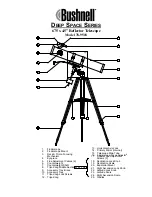
48
7.
Point the telescope at the object you want to photograph and center the guide star on the illuminated cross hairs and
you are ready to play back the periodic error correction.
8.
Once the drive's periodic error has been recorded, use the
Playback
function to begin playing back the correction for
future photographic guiding. If you want to re-record the periodic error, select
Record
and repeat the recording
processes again. The previously recorded information will be replaced with the current information. Repeat steps 7
and 8 to playback the PEC corrections for your next object.
Does the PEC function make unguided astrophotography possible? Yes and no. For solar (filtered), lunar, and piggyback (up
to 200mm), the answer is yes. However, even with PEC, off-axis guiding is still mandatory for long exposure, deep sky
astrophotography. The optional Reducer/Corrector lens reduces exposure times making the task of guiding a little easier.
As you perfect your technique, try specialized films, that is films that are designed or specially treated for celestial
photography. Here are some popular choices:
Ektar 125 (color print)
Fujichrome 100D (color slide)
Tech Pan, gas hypered (black and white print)
T-Max 400 (black and white print)
There is no exposure determination table to help you get started. The best way to determine exposure length is look at
previously published photos to see what film/exposure combinations were used. Or take unguided sample photos of various
parts of the sky while the drive is running. Always take exposures of various lengths to determine the best exposure time.
Terrestrial Photography
Your
telescope makes an excellent
telephoto lens for terrestrial (land) photography. Terrestrial photography is best done
will the telescope in Alt-Az configuration and the tracking drive turned off. To turn the tracking drive off, press the MENU
(9) button on the hand control and scroll down to the Tracking Mode sub menu. Use the Up and Down scroll keys (10) to
select the Off option and press ENTER. This will turn the tracking motors off, so that objects will remain in your camera's
field of view.
Metering
The CGEM Series telescope has a fixed aperture and, as a result, fixed f/ratios. To properly expose your subjects
photographically, you need to set your shutter speed accordingly. Most 35mm SLR cameras offer through-the-lens metering
which lets you know if your picture is under or overexposed. Adjustments for proper exposures are made by changing the
shutter speed. Consult your camera manual for specific information on metering and changing shutter speeds.
Reducing Vibration
Releasing the shutter manually can cause vibrations, producing blurred photos. To reduce vibration when tripping the shutter,
use a cable release. A cable release keeps your hands clear of the camera and lens, thus eliminating the possibility of
introducing vibration. Mechanical shutter releases can be used, though air-type releases are best.
Blurry pictures can also result from shutter speeds that are too slow. To prevent this, use films that produce shutter speeds
greater than 1/250 of a second when hand-holding the lens. If the lens is mounted on a tripod, the exposure length is virtually
unlimited.
















































